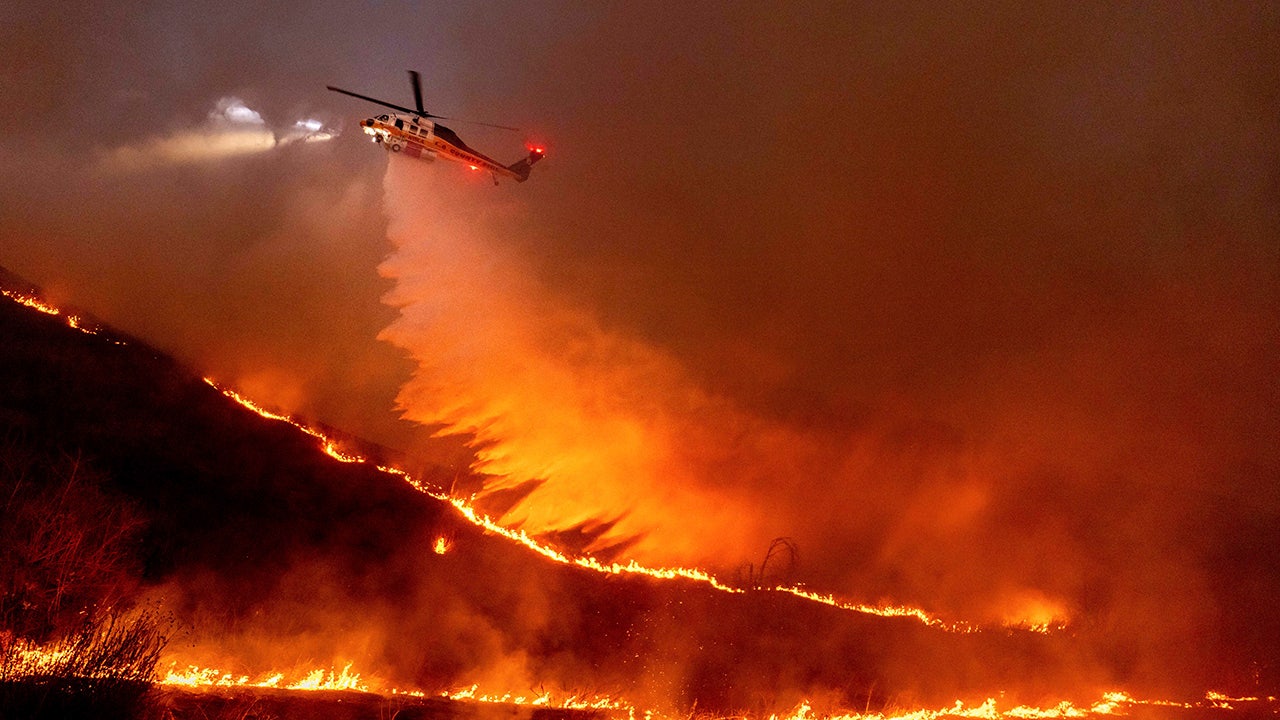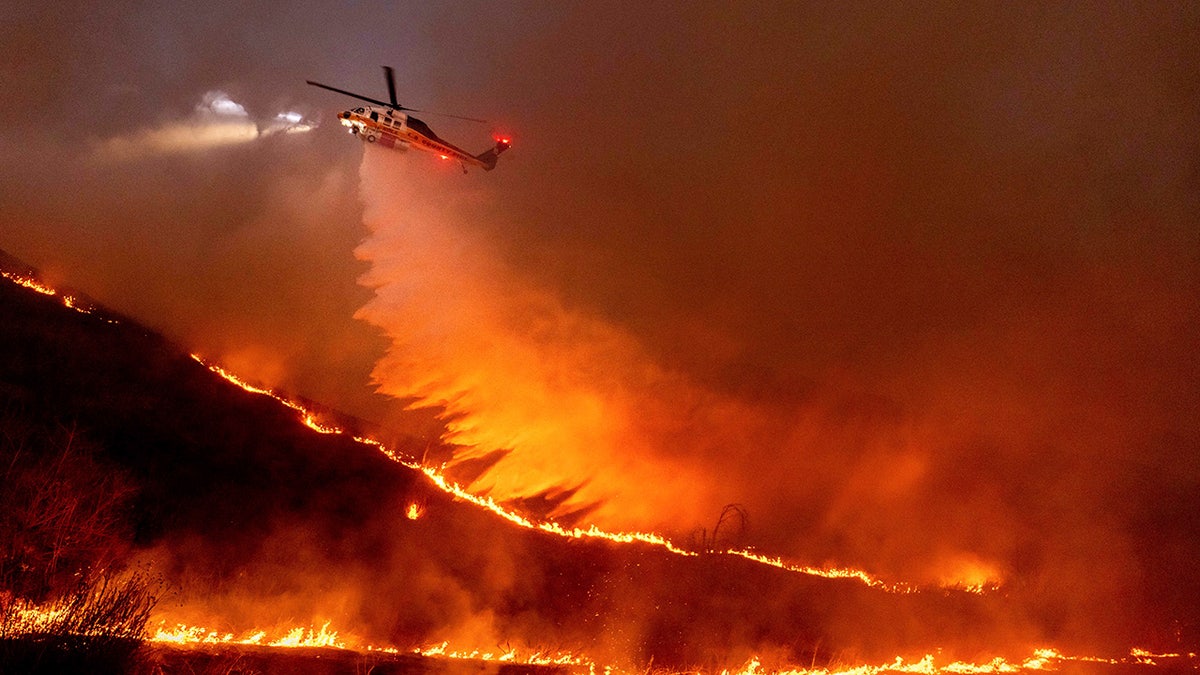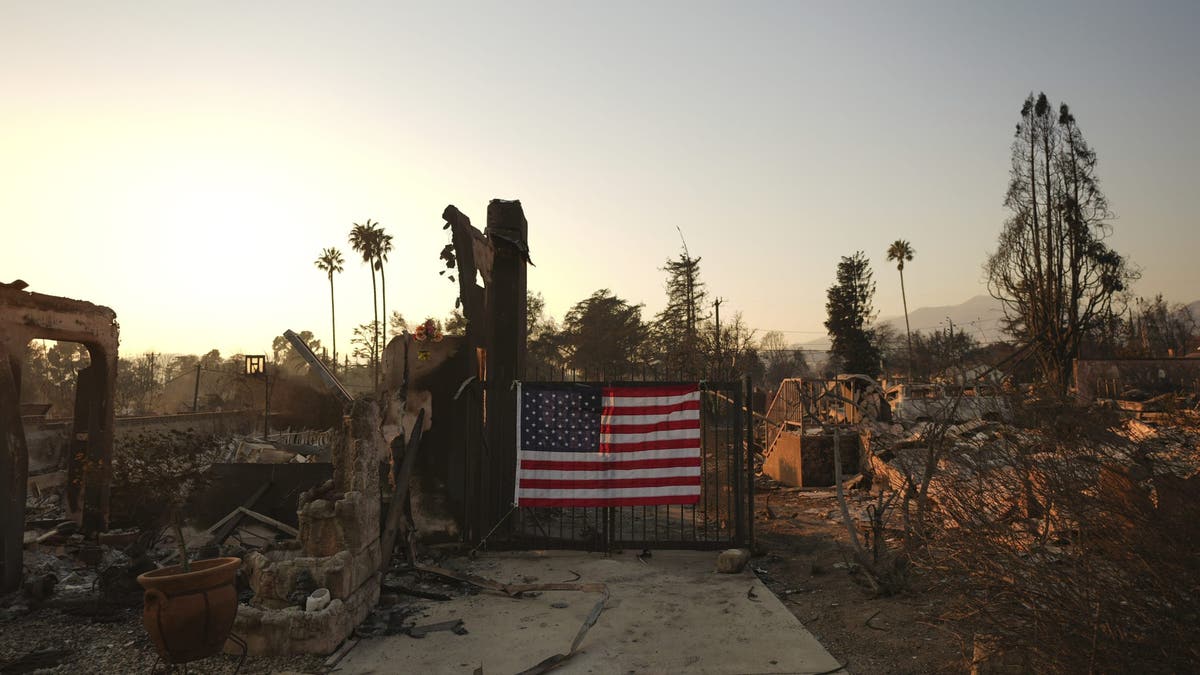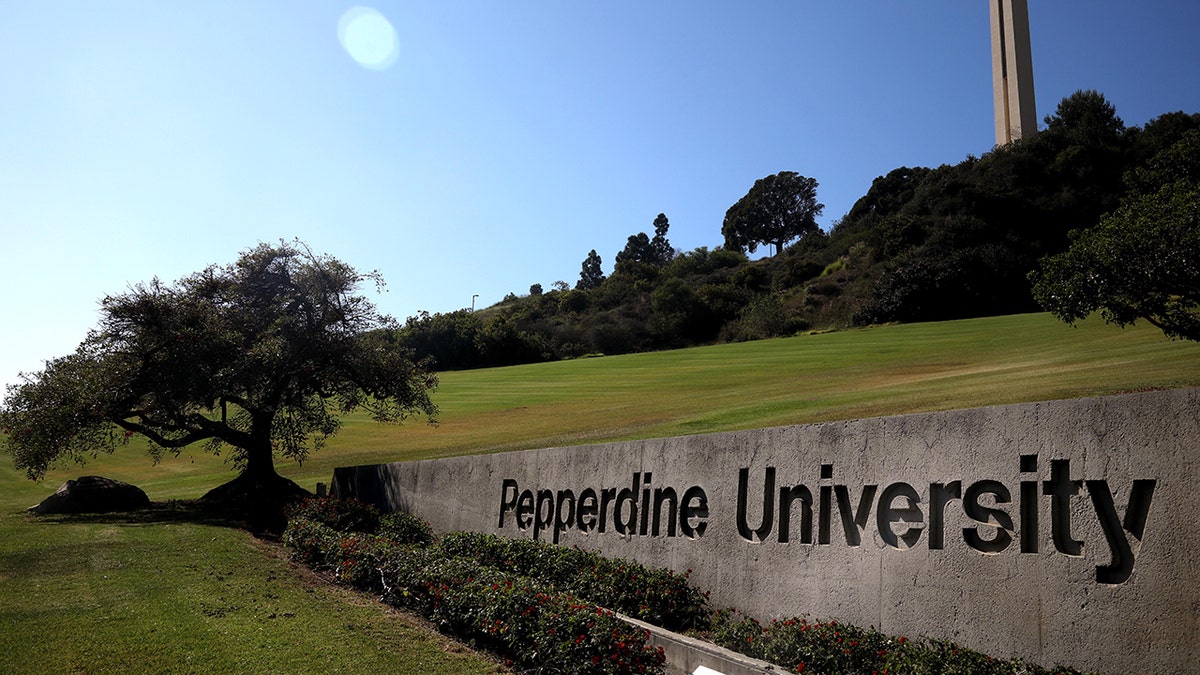West
Everything you need to know about the water drops in California during wildfires

Firefighters in California are battling the historic fires from the sky using a variety of effective and specialized aircraft that dump water and fire retardants over Los Angeles.
The state’s fleet includes tactical planes, air tankers, and helicopters. All have specific roles and capabilities but work together as a unit to combat the fires that have been raging since Tuesday. The fires have claimed 10 lives and torched tens of thousands of acres.
According to Cal Fire’s website, the fleet’s more than 60 planes and helicopters make it the largest department-owned fleet of aerial firefighting equipment in the world. Its fleet operates from 14 airfields and 11 helicopter bases across the state that can reach most fires within about 20 minutes.
A Super Scooper plane drops water on the Palisades Fire Tuesday, Jan. 7, 2025, in Pacific Palisades, Calif. (Brian van der Brug/Los Angeles Times via Getty Images)
POWER GRID FAULTS SURGED RIGHT BEFORE LOS ANGELES WILDFIRES BEGAN: EXPERT
Tactical planes often lead tanker planes, with the former providing directions and coordinates to the tankers and firefighters on the ground. According to Reuters, most of Cal Fire’s tactical planes are North American Rockwell OV-10 twin-turboprop, multi-mission aircraft that served with the U.S. Navy, Marine Corps and Air Force until the 1990s.
Cal Fire’s fleet of tankers then drops fire retardant onto the terrain below.
The Grumman S-2T tanker, with its two turboprop engines, is the agency’s workhorse and can hold about 1,200 gallons of fire retardant. Cal Fire also operates larger C-130 Hercules four-engine turboprop aircraft, which can dump about 3,000 gallons per load.
Cal Fire owns a fleet of helicopters, including Bell UH-1H Super Hueys and Sikorsky S70i Black Hawk helicopters. These helicopters can each carry water in buckets hanging below the aircraft to douse the flames.
John Mixson, a retired U.S. Coast Guard helicopter search and rescue aircraft commander, told Fox News Digital that the buckets, known as bambi buckets, can accurately drop water.
“They can get to any lake or reservoir, and they’re able to lower the bucket down into the water and then pinpoint deliver their payload. So, it’s a little more accurate than the fixed wing, but it’s a little less in quantity of either suppressant or water,” Mixson said.
“The helicopters can carry enough water to put out fires, of course, depending on the size of the fire. They also can saturate the ground to prevent fire from spreading. The buckets range in size due to the capacity of the helicopter carrying them, some only 70-ish gallons, some more than 2,000 gallons.”

Water is dropped by helicopter on the Kenneth Fire in the West Hills section of Los Angeles Thursday, Jan. 9, 2025. (Ethan Swope/AP)
HELP PEOPLE AFFECTED BY THE CALIFORNIA WILDFIRES HERE
Two Canadair CL-415 Super Scooper turboprop planes have also been deployed to battle the deadly infernos.
The Pentagon said Friday that two military C-130 Hercules aircraft equipped with a firefighting system are now on the scene, according to Military.com.
Six more C-130 airplanes are expected to be ready by Sunday. Some of the aircraft had to be refitted with firefighting systems because they were being used for cargo purposes. The fires have come outside the traditional firefighting season.
The scooper planes refill by descending to calm waters and skimming the water’s surface to load their tanks. They then release the water to douse a blaze and repeat the process until they need to refuel.
Super Scoopers have been loading up with saltwater from the Pacific Ocean, although this is fairly rare and typically avoided because it can damage equipment, infrastructure and wildlife, Frank Papalia, a former New York City Fire Department lieutenant and a fire safety expert at Global Security Group, told Fox News Digital.
Freshwater, whenever possible, is preferred because salt content is corrosive and can damage equipment like hoses and pumps.
ESSENTIAL PHONE NUMBERS FOR LOS ANGELES-AREA RESIDENTS AND HOW YOU CAN HELP

Airplanes scoop water from the ocean to douse the Palisades Fire in the mountains Jan. 9, 2025. (Sandy Hooper/Imagn)
“In this case, your city is burning to the ground, so using the saltwater is not that bad,” he told Fox News Digital.
Additionally, fire hydrants don’t use saltwater because they are not corrosion-resistant, but firetrucks can use saltwater. They just have to be close enough to get it and require thorough cleaning afterward.
Fire retardant isn’t dumped directly onto the fires. Instead, the chemical is dropped in front of a fire, directing its course or slowing its advance and giving ground crews a chance to control or extinguish it. Retardants can also be released to protect homes or important sites and to keep access roads open.
The substance is typically made of a mixture of water, fertilizer, a thickening agent and red dye. The red dye is added so firefighters can see the retardant against the landscape.
CALIFORNIA WILDFIRES RAGE INTO FIFTH CONSECUTIVE DAY WITH DEATH TOLL CLIMBING, FRESH EVACUATIONS
The pilots who man these aircraft are known as aerial firefighting pilots, or waterbombers.
Mixon says pilots are from different backgrounds, but many previously served in the military.
They typically have to undergo specific training on their respective type of aircraft to handle their unique capabilities and systems. Most aerial firefighting pilots already have years of experience flying before they ever take to the skies in a firefighting aircraft.
According to Hillsboro Aero Academy, an Oregon-based flight school, becoming a helicopter pilot involves accumulating between 1,500 and 4,000 hours of helicopter flight time as a pilot in command (PIC), a pilot responsible for the safety and operation of an aircraft.
The flight hours equip aspiring pilots with vital knowledge about aircraft systems, mission training and fire behavior, and candidates need to prove they can operate firefighting helicopters in challenging conditions such as mountainous terrain. They also need technical skills to work closely with ground crews and other aircraft during missions and knowledge of how fires spread and how to contain them using aircraft.

A tanker drops retardant as the Palisades Fire grows in the hills of Topanga, Calif., Jan. 9, 2025. (David Swanson/AFP via Getty Images)
The hours are similar for prospective fixed-wing aircraft pilots.
“The crews are all extremely highly trained specifically for the specialized mission,” Mixson said. “This isn’t a secondary mission for the Cal Fire folks or any of the DOD or Forest Service firefighting folks. Just like the U.S. Coast Guard, they are very, very specialized in what they do.
“It is very hazardous, very challenging, but they’re also very, very highly trained, uniquely to the specific task.”
One of the most apparent dangers is the low altitude above hilly terrain in high wind conditions, which is what they’re battling now, Mixson said.
Mixson pointed out that, through the smoke, these crews must also avoid other aircraft, terrain and everyday hazards such as radio towers.
The strong Santa Ana winds prevented firefighting aircraft from being deployed earlier this week due to safety risks.
Meanwhile, a drone smashed into one of the Canadian Super Scoopers, too. The impact left a fist-sized hole in the water, dropping the aircraft’s wing. No injuries have been reported. Cal Fire said it expects the plane to be back in the air by Monday.
Reuters contributed to this report.
Read the full article from Here

West
Horse racing, college basketball games postponed due to devastating wildfires across Los Angeles region

Wildfires have ravaged neighborhoods across Los Angeles in recent days.
More than 12,000 homes have been destroyed by ferocious fires that have left at least 11 dead.
A flareup of the wildfire on the city’s west side resulted in the latest evacuation order, prompting Santa Anita to cancel this weekend’s scheduled horse racing event.
The track in Arcadia, near the smoldering Eaton Fire that decimated Altadena, said Friday it planned to go forward with racing Saturday, depending upon air quality conditions.
Richi and jockey Kazushi Kimura, right, win the Grade III $100,000 Las Flores Stakes horse race Jan. 4, 2025, at Santa Anita Park in Arcadia, Calif. (Benoit Photo via AP)
However, track officials said Saturday racing would be canceled due to new developments with the Palisades Fire.
Air quality standards at the track remain well within the limits set by the California Horse Racing Board and the Horseracing Integrity and Safety Authority, according to track officials. However, organizers were concerned about the growing impact of the fires throughout Los Angeles County.
ROSE BOWL HALF-MARATHON AND 5K POSTPONED DUE TO WILDFIRES
The California Department of Forestry and Fire Protection confirmed 11% of the Palisades Fire was contained as of Saturday morning, while the Eaton Fire was listed as 15% contained.
The 90-year-old track in Southern California is also being used to support various relief efforts.

An American flag hangs on the gate of a home destroyed by the Eaton Fire in Altadena, Calif., Friday, Jan. 10, 2025. (AP Photo/Jae C. Hong)
A charity drop-off set up at the Rose Bowl was relocated to Santa Anita’s south parking lot Friday. Southern California Edison is using the entire north parking lot as its base to restore power to those in affected areas. The track is working with other organizations requesting space.
Morning training will continue as scheduled Saturday and Sunday. The track has its own security staff and does not use local first responders for normal events.
Rescheduled dates for the postponed races are expected to be announced at a later date.
The sports world has felt the impact of the unprecedented wildfires this week. Malibu was one of several areas hit hard by the Palisades fire.
Pepperdine University, which has a main campus on the Pacific Coast Highway in Malibu, postponed its men’s and women’s basketball doubleheader Saturday. School officials cited the Palisades Fire and travel conditions in Los Angeles.

Pepperdine University in Malibu Oct. 18, 2023. (Genaro Molina/Los Angeles Times via Getty Images)
However, Pepperdine’s Malibu campus remains clear of any immediate threats posed by the fire. But access to campus is restricted to the north side. The Pacific Coast Highway south of campus is closed.
Pepperdine and Loyola Marymount are in communication with the West Coast Conference about rescheduling. Elsewhere, the fourth-ranked USC women’s basketball team is scheduled to play a Big Ten Conference game against Penn State Sunday night. Officials are monitoring conditions, a spokesperson confirmed.
The Associated Press contributed to this report.
Follow Fox News Digital’s sports coverage on X, and subscribe to the Fox News Sports Huddle newsletter.
Read the full article from Here
San Francisco, CA
Building Decarbonization Could Push Out Low-Income Renters. A San Francisco Program Hopes to Prevent That – Inside Climate News

SAN FRANCISCO, Calif.—On a Wednesday in late September, Amparo Vigil showed a contractor around the modest, three-story building she owns in San Francisco’s outer Mission District. The contractor—just one of a handful visiting the building that week—toured the top floor apartment, where Vigil lives with her grandchildren, and the two one-bedroom units she rents out on the second floor. He took a close look at the kitchens, the furnaces and the electrical paneling and used a drone to get a good view of the roof.
The building—which abuts another one Vigil’s sister and father own and out of which her family operates Puerto Alegre, one of a pair of popular Mission restaurants—is about to undergo a comprehensive renovation as one of three demonstration projects funded by the San Francisco Department of the Environment’s Healthy Resilient Homes Project.
“I know enough about climate change to know that things are getting worse, and that things have already gotten worse,” said Vigil, who has lived in the building for 28 years. Just a week earlier the city famous for its cold summers had nearly a week of 90-degree days.
Like a patient preparing for long-awaited surgery, Vigil was reticent about how the renovation project would unfold, but looking forward to feeling more prepared for the increasingly unpredictable climate.
We’re hiring!
Please take a look at the new openings in our newsroom.
See jobs
The list of changes include a small solar panel array, heat pumps and other all-electric appliances, an EV charger and improved insulation. The estimated cost of taking the building off natural gas completely and making it more climate resilient will be more than $125,000, but Vigil won’t be left with the bill. It will instead be paid by People Organizing to Demand Environmental and Economic Rights or PODER SF, a group whose name means “power” in Spanish that works to ensure that Mission residents have a voice in shaping policy related to housing, transportation and community development.
But PODER’s project also has a larger purpose than helping Vigil update her building. It’s designed to help advocates gauge the cost of decarbonizing low-income rental properties across the city and beyond as a group of environmental justice advocates prepare a larger plan to bring these kinds of changes to a population that has until now been mainly shut out of the clean energy transition.
In a city that looks little like it did 20 years ago, San Francisco’s outer Mission District neighborhood has remained a place for Latino families to live and work. Its central artery, 24th Street, runs past taquerias and locally-owned stores selling fresh produce and tortillas. On the Day of the Dead, it provides a route for a small, annual parade that winds its way through the neighborhood to a festival of altars where community members from across Latin America honor lost loved ones.
The fact that this neighborhood remains more or less intact after multiple waves of gentrification displaced one third of Latino Mission residents between 2000 and 2019 is no accident. It’s the result of thousands of hours of organizing by a network of community-based nonprofits that work to anchor the people to the neighborhood. And at the center of this constellation is PODER SF.
In 2023 the group saw a long-time plan come to fruition when Casa Adelante, an affordable 143-unit all-electric apartment building was finally completed. PODER had been advocating for the project since it took over a parking lot with four other groups of housing advocates in 2000.
Then, earlier this year, when PODER SF and a handful of other groups were invited by the Department of the Environment to launch the San Francisco Healthy Resilient Homes Demonstration Projects, Vigil put her name in the hat. A long-time member of PODER and life-long Mission resident, she treated her renters more like family than clients—keeping the rent below market rate and making it possible for one family to stay for decades. When another family moved out, she filled their space with a woman who had cared for Vigil’s mother in her final years, along with the caretaker’s husband and nephew.

Knowing this about Vigil, and aware that the choice to maintain what urban planners call “naturally occurring low-income housing” can keep renovations out of financial reach, PODER chose her building.
“Her home is there and her family members live there as well,” says Antonia Diaz, PODER’s organizational director. “Since we are aiming to have the retrofits covered 100 percent, there would not be any pass-through costs to the tenants.”
Building electrification is central to both the state’s greenhouse gas reduction and air quality strategies. Electric appliances can run on renewable solar, wind and hydroelectric power, and are more efficient with energy than gas appliances.The Bay Area’s air district will soon require all broken furnaces and hot water heaters to be replaced by electric heat pumps, and California aims to install 6 million heat pumps in the next five years. San Francisco’s Climate Action Plan aims to specifically phase out natural gas in all buildings by 2040.
While some state and federal funding has been made available for low-income homeowners to decarbonize, not much has made it to renters or landlords. That’s beginning to change, but some environmental justice advocates are concerned that this next wave of building electrification—like other renovations—could raise property values and increase owner turnover, resulting in rising rents and tenant displacement in communities that have already been hit hard by the state’s housing crisis. The Poder SF demonstration project, and others like it, are an effort to head off that likelihood.
“There are concerns about ‘renovictions,’ there are concerns about cost pass-throughs, and so tenant protection is a really big, explicit focus for us,” said Benny Zank, building decarbonization coordinator at the San Francisco Environment Department. The department has created a Climate Equity Hub aimed at replacing gas-fired hot water heaters with heat pumps in low-income tenants’ homes in a range of neighborhoods, in addition to the demonstration projects.
Decarbonization Without Displacement
Chelsea Kirk, a research and policy analyst at Strategic Action for a Just Economy (SAJE), a Los Angeles-based tenant’s rights nonprofit, points to other policy shifts that have put renters in danger of renovictions in the past. In LA, for instance, a seismic retrofit ordinance required landlords to upgrade 12,000 buildings to better prepare them for earthquakes.
“We’ve seen several cases of tenants being evicted, harassed and subject to illegal and shoddy construction that has made their homes unsafe as a result of that ordinance,” said Kirk, who authored a 2023 report on tenant protections in building retrofits throughout California. “Property owners used that [ordinance] as a pretext to displace people, and so we’re worried it’s going to happen again but on a wider scale” with renovations to combat climate change.
Renter protections for California tenants vary greatly by city, but the SAJE report points out that every year more than half a million renters in the state receive eviction notices.
“Many cities allow evictions when the landlord wishes to move in, repurpose, or renovate the property or unit,” the SAJE report reads. “Decarbonization work that leads to rent increases that low-income households cannot afford or to buildings that are unsafe for tenants to live in, even temporarily, will trigger more evictions.”
Kirk said SAJE wants to see preventative policies passed to better protect renters.
Poder SF had a hunch that it was possible to electrify a range of affordable housing locations in ways that would benefit both the landlord and their tenants. The group sees the demonstration project at Vigil’s building as a trial run for the state’s $500 million Equitable Building Decarbonization Program (EBD), which will roll out in 2025 and scale up in neighborhoods like the Mission.


PODER SF was one of a handful of groups that worked to ensure that the state’s upcoming EBD included limitations on rent increases for five years for small buildings and 10 years for larger buildings. The EBD program also requires that property owners commit in writing that building retrofits done through that program can’t be the basis for just cause eviction.
“It remains to be seen how well those are enforced, but it’s still really promising to see,” said Sneha Ayyagari of the climate justice-focused nonprofit Greenlining Institute, another group that advocated for inclusion of renter protections in the program. The question of enforcement is a big one, especially in the case of large corporate landlords, who are more likely to be beholden to investors than tenants.
San Francisco is known for having relatively strong protections for renters, but that doesn’t make it immune to the problems of displacement and gentrification, said Antonio Diaz, organizational director at Poder SF. Having to leave a rental unit during a renovation and look for housing in an expensive market for an extended period can leave working-class tenants in precarious situations that often push them out of the city, he said.
“Those of us working on building decarbonization from an equity perspective recognize that unless housing is a fundamental right and not a commodity for building owners to extract value from the land and tenants, vulnerable renters will be in precarious living conditions,” added Diaz.
Cutting the Cost of Electrification and Electricity Bills
Building decarbonization is also shining a light on the lack of ongoing investment in low-income housing throughout the state.
“You’re coming around talking about replacing expensive appliances, but a lot of us need to upgrade basic weatherization,” said Michelle Pierce, executive director at Bayview Hunters Point Community Advocates—another group working on a pilot project with SF Environment Department. “Many of our city’s buildings are 100 years old or older, so you’re going to go in there, ready to do this, and the foundation is crumbling. Then you’re looking at a $200,000 install, as opposed to a $10,000 job.”
In one recent case Pierce said what was supposed to be a simple hot water heater installation took three times longer than scheduled because the building required new pipes to accommodate the appliance.
This story is funded by readers like you.
Our nonprofit newsroom provides award-winning climate coverage free of charge and advertising. We rely on donations from readers like you to keep going. Please donate now to support our work.
Donate Now
Energy costs for low-income tenants are also a significant focus of programs aiming to make the energy transition more just.
Last year, Diaz and Christine Selig, a long-time Mission resident and member of the PODER SF advisory board who worked closely on the demonstration project, co-wrote a white paper with the Natural Resource Defense Counsel (NRDC), Physicians for Social Responsibility and several other groups about the need for an equitable transition to residential electrification. “Despite using less energy on average per household, lower-income communities and communities of color spend disproportionately more on their monthly energy bills than do wealthier households,” they wrote. The median energy burden of low-income households is three times higher than other households. Despite this fact, most decarbonization programs fail to “meaningfully engage communities in program design processes, decision-making, and implementation,” they added.
In San Francisco, those same communities are increasingly vulnerable to extreme heat and wildfire smoke because many of the city’s aging buildings don’t have central heating or HVAC systems. Vigil’s building, for instance, has neither. The addition of heat pump mini splits, which provide both heating and air conditioning, will be a major improvement.
“If we have one unbearably hot day, we open the windows, and we’re surviving,” said Vigil. “If we have two hot days, we’re kind of suffocating in it. And by day three, we’re like, ‘OK, we’ve got to get out. It’s not gonna work.’”


Investing in improved insulation is key, said Selig. Despite the added efficiency, one danger of simply switching gas for electric is that the latter costs a great deal more in the Bay Area. “When you simply electrify a low-income home, the electrical bill can go up a lot,” said Selig. The addition of solar panels alongside improved insulation is the best way to ensure that doesn’t happen, she said.
“There is little comprehensive data on the true cost of a whole-home approach to decarbonization because it tends to be so cost prohibitive,” said Selig. For that reason, it hasn’t been done for low-income households.
In addition to the $75,000 Poder’s demonstration project in Vigil’s building has received from two separate city programs, she said they’re hoping to stack several other state and federal incentives and rebates to cover the rest of the cost.
Fueling Community Buy In
Despite what may seem like an obvious windfall for Vigil and her tenants, home electrification isn’t always an easy sell for landlords or tenants, says Pierce, with Bay View Hunters Point Community Advocates (BVHPCA). The organization chose to work with a community center known for its kitchen rentals for a demonstration project focused on exposing more people to induction cooking. The group has also been conducting a study of residents in the majority-Black Bayview and Hunters Point neighborhoods to get a sense of how familiar they are with the concept of building decarbonization.
“One of the things that we’ve had to explain to government officials is that for our communities, a gas stove is the kind of luxury item that it can take a family a generation to own. So people are hesitant to have it taken away,” said Pierce. She added that many residents they have polled associate electric appliances with fires and electrocution. “We find ourselves explaining that this newer stuff that we’re talking about is less likely to catch on fire than a conventional electric stove or a gas stove,” she added. “These sentiments are fixed in the culture. So we have a lot of educating to do.”
In the next phase of the work, Poder SF, BVHPCA and the national nonprofit Emerald Cities Collaborative, which is decarbonizing and retrofitting an affordable deed-restricted building as the city’s third demonstration project, hope to start planning for a broader effort to electrify all the city’s under-resourced eastern neighborhoods. Doing so would require an expensive transformer upgrade in the area and an education campaign about the values of disconnecting from the gas infrastructure.
It won’t happen fast, but advocates say that large-scale decarbonization—and the emissions reductions it promises—is only possible if low-income households are included in the plan.
“If you look at the population of California, a very high percentage of people live in multifamily buildings and a very high percentage are rent-burdened,” said the Greenlining Institute’s Sneha. “So, if you’re truly going to address the problem, you need to figure out equitable pathways to do so.”
Selig echoed that sentiment. “People say, ‘How can we put all this money into transforming building stock?’ It’s going to be a very expensive project, but it does create good jobs, and it builds resiliency—and it’s not as expensive as climate catastrophes.”
Kelechukwu Ogu contributed reporting.
This story was produced with support from the Climate Equity Reporting Project at Berkeley Journalism.
About This Story
Perhaps you noticed: This story, like all the news we publish, is free to read. That’s because Inside Climate News is a 501c3 nonprofit organization. We do not charge a subscription fee, lock our news behind a paywall, or clutter our website with ads. We make our news on climate and the environment freely available to you and anyone who wants it.
That’s not all. We also share our news for free with scores of other media organizations around the country. Many of them can’t afford to do environmental journalism of their own. We’ve built bureaus from coast to coast to report local stories, collaborate with local newsrooms and co-publish articles so that this vital work is shared as widely as possible.
Two of us launched ICN in 2007. Six years later we earned a Pulitzer Prize for National Reporting, and now we run the oldest and largest dedicated climate newsroom in the nation. We tell the story in all its complexity. We hold polluters accountable. We expose environmental injustice. We debunk misinformation. We scrutinize solutions and inspire action.
Donations from readers like you fund every aspect of what we do. If you don’t already, will you support our ongoing work, our reporting on the biggest crisis facing our planet, and help us reach even more readers in more places?
Please take a moment to make a tax-deductible donation. Every one of them makes a difference.
Thank you,
Denver, CO
Denver city leaders respond after stabbings on 16th Street Mall

Watch CBS News
Be the first to know
Get browser notifications for breaking news, live events, and exclusive reporting.
-

 Politics1 week ago
Politics1 week agoWho Are the Recipients of the Presidential Medal of Freedom?
-

 Health1 week ago
Health1 week agoOzempic ‘microdosing’ is the new weight-loss trend: Should you try it?
-
/cdn.vox-cdn.com/uploads/chorus_asset/file/25822586/STK169_ZUCKERBERG_MAGA_STKS491_CVIRGINIA_A.jpg)
/cdn.vox-cdn.com/uploads/chorus_asset/file/25822586/STK169_ZUCKERBERG_MAGA_STKS491_CVIRGINIA_A.jpg) Technology5 days ago
Technology5 days agoMeta is highlighting a splintering global approach to online speech
-

 Science3 days ago
Science3 days agoMetro will offer free rides in L.A. through Sunday due to fires
-
/cdn.vox-cdn.com/uploads/chorus_asset/file/25821992/videoframe_720397.png)
/cdn.vox-cdn.com/uploads/chorus_asset/file/25821992/videoframe_720397.png) Technology6 days ago
Technology6 days agoLas Vegas police release ChatGPT logs from the suspect in the Cybertruck explosion
-

 Movie Reviews1 week ago
Movie Reviews1 week ago‘How to Make Millions Before Grandma Dies’ Review: Thai Oscar Entry Is a Disarmingly Sentimental Tear-Jerker
-

 News1 week ago
News1 week agoTrump Has Reeled in More Than $200 Million Since Election Day
-

 Movie Reviews1 week ago
Movie Reviews1 week agoMovie Review: Millennials try to buy-in or opt-out of the “American Meltdown”













